|
FAQs on Platy Diseases/Health
11
FAQs on Platy Disease:
Platy Disease 1,
Platy Disease 2,
Platy Disease 3,
Platy Disease 4,
Platy Disease 5,
Platy Health 6,
Platy Health 7,
Platy Health 8,
Platy Health 9,
Platy Health 10,
FAQs on Platy Disease by Category:
Diagnosis,
Environmental,
Nutritional (e.g. HLLE),
Social,
Infectious (Virus, Bacterial, Fungal),
Parasitic (Ich, Velvet...),
Genetic,
Treatments,
Related Articles:
Platies,
Poeciliids:
Guppies, Platies, Swordtails, Mollies by Neale Monks,
Livebearing Fishes by Bob
Fenner,Related FAQs:
Platies 1,
Platies 2,
Platy Identification,
Platy Behavior,
Platy Compatibility,
Platy Selection,
Platy Systems,
Platy Feeding,
Platy Reproduction,
Livebearers,
Guppies,
Swordtails,
Mollies,
|
|
|
Platy swim bladder problem 12/19/19
Greetings!
<Happy holidays Melita>
I have found many answers here in the past (thank you!), but now
have a situation where I'm not sure how best to proceed.
Apologies in advance if I'm providing too much information, I
figure always better too much than not enough.
<Yes; agreed>
I've had a female platy for about a year and a half now. She was
normal and healthy for most of the first year. This is what she
looked like when I first got her, around August of 2018. Not
full-grown yet, and didn't seem to arrive pregnant (as most
female livebearers do) either.
[image: platyAug18.jpg]
<Very nice; fully mature female>
|
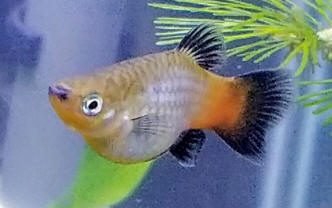 |
|
I'd kept her with a pair of peppered corys and
trio of female swordtails, and one male swordtail (who never
tried to mate with her, that I ever saw - his trio of ladies
kept him busy enough, I think.)
<Mmm; can cross breed w/ platies>
[Since this is going to be mostly history to where we are now I
don't think water parameters are or were a factor - but for the
record she was in a mature, well-planted tank. pH 7.8-8.2, temp
74, gH >180, kH >180 and maintained with crushed coral in the
canister filter, am 0, nitrites 0, nitrates 10-20, 25% water
change weekly.
<Good values, maintenance>
The only issue I've had in this tank was a case of external
Columnaris on one of the swords (white lesion, treated with
hydrogen peroxide direct-swab since it was near the tail,
followed up with a course of Nitrofuran/Kanaplex in the tank.
This also happened months before there were ever any issues with
the platy. Don't know about the UK, but here in the US it seems
like Columnaris has become frightfully common with livebearers.
<It is... and has been, "cyclically"... every few years off and
on for decades. Many folks cite, speculate that the
international import may be a root cause (difference in water
quality, stress...), and quality of
domestic water, and loss of genetic strength in lines....>
Enough so that I've even been seeing them shipped in yellow
water rather than blue - an indication of
Nitrofuran in the water, rather than Methylene Blue.]
<Could/might well be>
She would periodically cycle getting a little larger in the
belly and then smaller, but if she ever produced any offspring I
never saw it (didn't see her birth any fry, never saw her hiding
or getting particularly stroppy with the others (like the female
swords do when they're getting close to birthing), didn't see
any offspring with colors like hers or that didn't look like
regular swordtail in fin/body shape, etc.)
<Young might have been consumed.>
This would be a 'fatter' period for her, in February 2019.
[image: platyFeb19_fat.jpg]
|
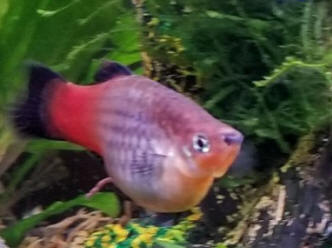 |
|
One day in June of 2019, she started head-standing, and her
vent had also become rather prominent.
[image: platyJun19_1.jpg]
|
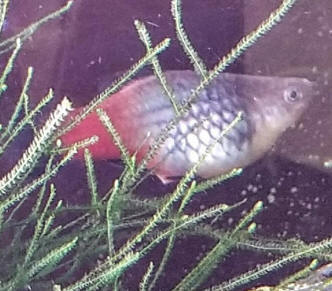
|
|
<Yes; the vent area often becomes clear/er ahead (days) of
parturition; one can sometimes see the eyes of young through
this area at the time>
It coincided with feeding the tank a treat of frozen brine
shrimp (though I didn't make the connection until later.) I
removed her to a quarantine, someplace quiet away from the other
females - in case she was pregnant and having trouble birthing.
<Okay... I'd advise placing "spawning medium" (artificial or
live "grass"... there are a few varieties; gone over on WWM on
the Aquatic Plants subweb>
By the next morning she was oriented normally again. No fry. I
kept her in the quarantine for a couple more days, but as she
was acting completely like her normal self (wanting to be fed,
pooping normally, etc), I went ahead and put her back in the
tank.
<A few things might have occurred here; false pregnancy,
resorption... Good
to either use large breeding nets/traps and/or move apparently
"pregnant" females well in advance.>
Things were fine for some time after that, but - if there was an
occasion where she could scarf down 'extra' food (such as frozen
brine shrimp), she'd end up in the head-standing position again
for several hours to half a day after. I figured - overfull
stomach pressing on swim bladder.
<Might be; and/or gas generation from the food>
This was her in August 2019, still normal most of the time.
[image: platyAug19_normal.jpg]
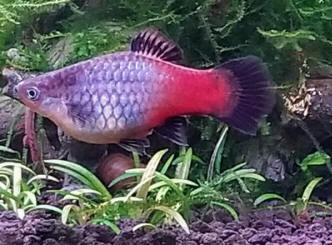
|
|
She'd always been a bit of a chow-hound, even more than most
livebearers are.
I'd read (from other places) that head-standing in platys was
basically a death sentence; but since she was still swimming
normally, eating normally, pooping normally, and so on, I just
let her be.
Sometime in September, the head-standing got to be a constant
thing. She would position herself under something (plant leaf,
decoration) to stay horizontal and away from the surface. But
the female swords decided that there must be something wrong
with her, and they started picking on her constantly (more than
just the normal female pecking-order squabbles.)
They meant business, so I had to move her.
I moved her back into quarantine, and gave her a week's course
of Nitro/Kanaplex just in case it was due to some kind of
infection. Didn't make any difference.
The only other thing I could find about this problem was that
she might be egg-bound.
<Yes; or possibly have decomposing young inside her>
So, I went and got a male platy (same kind) and another female
(so he wouldn't be focused exclusively on her), both half her
size so she could assert herself easily if either one of them
bothered her too much.
Put them into a planted 20-gal tank.
She was still positioning herself under anything she could.
After a month, things were no better - and she was going
downhill from the additional stress of having a male trying to
court her. Started showing signs of edema/dropsy - not to the
point of her scales pine-coning or pop-eye, just swollen and
looking uncomfortable.
I removed her to quarantine again, and this time I thought I was
going to lose her. She was tail-curling, like she was in pain
and trying to reach the painful spot with her mouth. I gave her
an Epsom bath in a smaller container for 30 min.s, and then put
some salt
<Aquarium salt I take it, not Epsom>
and meth blue into the quarantine (just hoping to make her a
little more comfortable) and left her overnight, fully expecting
to find her dead the next morning.
But, she wasn't. She was much less swollen, had made a
black-looking, somewhat larger than normal poop, and she now had
a red spot on her side (the side she'd been curling toward.) A
day or so later it also looked like she had some bruising under
her skin, on both sides.
[image: platyOct19.jpg]
[image: platyOct19_2.jpg]
|
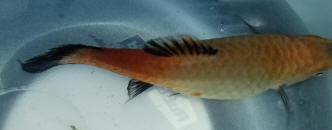 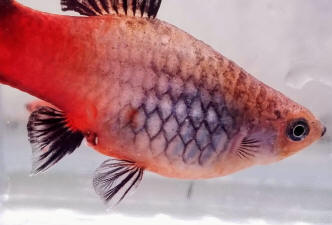 |
|
She didn't eat for nearly a week after this. The quarantine I
had her in was bare-bottom, just a heater and airstone - I was
taking her out and doing full water-changes every day or at most
every other day (still expecting she'd either start getting
better or go farther downhill, figuring either way it was just
temporary lodging.) At one point I was considering getting out
the clove oil - but she let me know she wasn't done.
She had also had some dorsal and caudal fin damage (from
floating to the surface, drying out), so I'd coated my hand with
StressCoat and picked her up to put her back in the quarantine
after the water-change (easiest way to get it onto her where she
needed it.) She surprised me with her strength, fighting; she
was not at all hesitant to let me know how much she didn't
appreciate being handled. She was plenty feisty when trying to
catch her to do the water-changes as well.
When she started eating again I tried a few other things with
her - a course of Triple Sulfa, I think I also tried her with
some Ciprofloxacin (in the water, I didn't try medicated food
because she isn't seeing/eating food right away and I know it
loses its effectiveness quickly in the water.) No change, for
better or worse.
And now here we are in December, two months later - still no
change. She spends the majority of her time positioned
underneath something to stay down (the heater, or tube-caves I
made for her out of an opaque plastic bottle), and when she's
not under something, she's tail-up unless she's actively
swimming. She eats and poops normally. And still has the red
spot, this is a picture from yesterday:
[image: platyDec19_now.jpg]
|
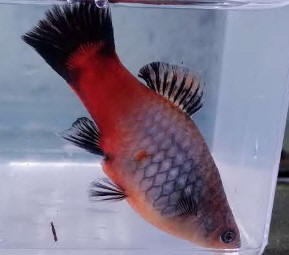 |
|
At this point, I don't know what else I should do for her.
Set her up by herself in a 10-gallon with plants and other
'soft' things to position herself under, I guess? She doesn't
tend to swim around a whole lot now, I think anything larger
(tank-wise) would be sort of pointless. It doesn't seem like
much of a life to me, but given how actively/strongly she still
fights being caught or restrained in any way, I'd also say she
isn't 'done' in her own mind, definitely hasn't given up.
Thought I'd pose this one to you all, see if there is something
else you would suggest.
Thanks in advance,
Melita
<I would have you read Neale's piece on salt use:
http://www.wetwebmedia.com/FWSubWebIndex/SaltUseFWArtNeale.htm
and consider either the addition of Epsom salt or its use in a
more concentrated bath/lavage... in an attempt to "loosen" what
might be inside this fish. Please do report back your actions
and observations. Bob Fenner>
Re: Platy swim bladder problem
12/20/19
and one male swordtail (who never tried to mate with her, that I ever saw-his
trio of ladies kept him busy enough, I think.)
<Mmm; can cross breed w/ platies>
Yes, I knew they could - it wasn't a big deal to me if they did, this tank was
more for display than breeding (it's in my office at work.) Was mainly just
noting that I never saw any breeding activity between them; he didn't seem
interested in trying with her, he was always focused on the sword
females.
<Young might have been consumed.>
Oh, definitely, with this bunch. Though not so much when they were
younger/smaller themselves; I did have a lot of fry survive early on, when the
female swords were younger/smaller. But now, they not only eat all their own
fry, they also follow the corys around when they're spawning and eat all the
eggs as soon as the female places them.
<<Yikes!>>
<Okay... I'd advise placing "spawning medium" (artificial or live "grass"...
there are a few varieties; gone over on WWM on the Aquatic Plants subweb>
The tank actually is heavily planted, with masses of Java and Christmas moss,
floating Salvinia minima, thick mats of Java ferns at one end, and a stand of
bushy Limnophila aromatica mixed with two varieties of Cabomba in the middle.
Even with all that, plus a tumble of stones with gaps that fry could hide in -
they generally still are all consumed.
<<Ahh>>
I'll see 10 or 12
of them hiding in the moss or other plants the day or so after they're born,
then it'll be down to 4-5 the next day, and then maybe once in 2-3 months a
single fry might survive past snack-size. The female swords especially are
relentless - they'll push their way in among the plants and remain still,
waiting for fry to show themselves. Like some kind of miniature grouper, lurking
in a reef cave. You'd think they don't get fed regularly....
<A few things might have occurred here; false pregnancy, resorption...
Good to either use large breeding nets/traps and/or move apparently "pregnant"
females well in advance.>
Sorry, poor explanation on my part of why I moved her. It's a long tank, and
when the swords start zipping around (male/female courting, or females
displaying/chasing for pecking order) I didn't think it would be a great place
for a fish who is struggling with buoyancy issues and potentially labor/birthing
issues as well. Where I was moving her to was just a dark, quiet place where she
wouldn't be bothered by the swords if (when) they got too rambunctious; I wasn't
really concerned about saving fry (if there
were any; I tended to think as you suggest, false pregnancy or reabsorption.) If
she'd been giving birth under normal circumstances, I wouldn't have felt any
need to move her - I'd expect she'd have gone to an out of the way corner on her
own, like the swords typically do when they're birthing.
<<I see>>
<I would have you read Neale's piece on salt use:
http://www.wetwebmedia.com/FWSubWebIndex/SaltUseFWArtNeale.htm
and consider either the addition of Epsom salt or its use in a more concentrated
bath/lavage... in an attempt to "loosen" what might be inside this fish. Please
do report back your actions and observations. Bob Fenner>
Many thanks, and I will try that and see what happens.
I will also completely date myself by saying that my first tank was a
slate-bottom Metaframe, *grin*.
<<Wowzah. My generation!>>
I was out of the hobby for decades, though, and am only recently back in; so I
do still remember (and use) all the old standbys (salt, meth blue, malachite
green, potassium permanganate, Epsom, Merbromin.)
<<I do recall>>
Can snip this next part from public posting if you like, because it's sort of a
tangent - but I had seen the piece on salt use, because I had also read through
all the platy pages before posting. I will respectfully and carefully venture to
disagree on one point from one of the platy posts, though - which was that salt
is ineffective for any bacterial infection (IIRC it was Neale who responded that
someone would have to be an idiot to use salt for anything bacterial; the
context was in relation to fin rot, I believe.)
<<In this case, I side w/ you; have experienced salt use being effective
for apparently bacterial issues. Other sources state this as well.>>
I do agree that salt is likely ineffective for internal bacterial infections -
it's probably only beneficial from the aspect that he also cites in the uses
(osmoregulation). And I agree that it's also not effective for all types of
bacteria - Streptococcus (for example) survives in saltwater just fine.
But I've successfully used aquarium-salt baths to treat external Columnaris
lesions (I do also keep swords and guppies at home), when I didn't have anything
else to hand. Later also found this study showing that a 4% salt solution had a
measurable effect on F. columnare viability in a lab setting.
https://www.ncbi.nlm.nih.gov/pubmed/16060264
<<Ah yes>>
(it also shows that the 4% salt solution did not reduce mortality in infected
fish, but posits that the bacteria is protected by the fish's mucus layer. Which
makes sense; infection occurring below that layer, the bacteria probably isn't
ever coming into direct contact with the salt solution. But, Columnaris can also
be one of the many potential causes of fin rot in freshwater fish; so in that
case, salt potentially could be
effective.)
Another study seems to show that salt is potentially also effective against
Aeromonas (yet another potential fin rot causative agent) and Edwardsiella; from
this Auburn study done on channel catfish (which kind of also puts a kink in the
conventional wisdom that non-scaled fish don't tolerate salt
well):
http://www.int-res.com/articles/dao/21/d021p171.pdf This one is
interesting because they conclude by saying they aren't sure themselves what the
real benefit was; including that it might only be physiologically beneficial on
the fish itself (again, likely improved osmoregulation).
The advice is still sound for the intended audience - most people aren't going
to bother to delve into wheres and whys and hows like I do, not going to
differentiate one bacterial vector from another (most also don't understand the
difference between gram-positive and -negative, and why an antibiotic that
targets gram-positive isn't going to work for a gram-negative like Aeromonas.)
Mostly just saying that if someone does claim that salt helped a particular
bacterial-vector condition, they might not be wrong or misinformed. Or an idiot.
:)
<<Assuredly Neale Monks is not the latter. I don't recall his reasoning, but he
and I have chatted about this years back. BobF>>
Re: Platy swim bladder problem 12/20/19
<<Assuredly Neale Monks is not the latter. I don't recall his reasoning, but he
and I have chatted about this years back. BobF>>
No, no, definitely was not suggesting he was - I respect his knowledge and
experience, and have been educated and informed by many of his past answers
here.
I was only quoting the response that anyone who used salt for bacterial would
have to be an idiot. Meaning - I don't think anyone who does try/use salt for
external bacterial is misinformed or an idiot - because I have seen some
evidence that it can be effective, and I don't think *I'm* an idiot.
[But of course, I also might not be completely objective when it comes to
self-evaluation.... :) ]
<I consider that there is some subjective element/s to all observations,
thinking. Cheers, B>
|
Re: Platy swim bladder problem 1/24/20
Just an update on the platy with the swim bladder problem - new pics, but no
real change to her condition.
<Understood.>
Still basically the same, looks a little less 'bruised' under the skin now.
The red spot, I think in this particular pic is some part residual coloring
from having previously given her a swab of merbromin there (still not even
sure whether it's an external wound, or internal and showing
through the skin.)
<Nor I; while this fish does look normal in terms of shape, with no evidence
of raised scales or even obvious bacterial inflammation, the swimming
posture remains odd. On top of that, the paleness of the skin can indicate
excessive mucous production, something relatively common in ailing
livebearers.>
I still don't know what originally caused that particular red spot. Like I
said in the first post, it appeared after she'd gone through a period of
tail-curling, looking like she was in pain and looking like she was trying
to reach about that area with her mouth.
<Indeed, and sometimes if there is something amiss with her offspring, such
as stillbirths or even decomposition of embryos within the uterus, it is
fairly clear the female fish is stressed.>
She's still eating (and pooping) normally. I pretty much only feed her
sinking food now, because it's easier for her to find and pick up. And she
still can be quite feisty if you try to catch her, she's still not acting
like she's ready to call it quits.
<That's promising, at least.>
I stopped the Epsom baths after 4-5 days because she's really not swollen;
in fact she is about as slim as she's ever been.
<Agreed.>
I'm also guessing that if there was anything still 'in' her to be gotten
out, she'd have gone septic long before now and died (given that she's been
like this for several months now, and is otherwise not acting like she feels
ill.)
<Also seems about right; I would carry on what you are doing, though perhaps
focusing on laxative foods (Daphnia for example, or cooked peas) to help
rule out constipation as a complicating factor.>
Based on her behavior at the time that she was acting like she was in pain,
and what she looked like shortly after that, I'm guessing something might
have ruptured inside? Something not life-threatening - uterus perhaps?
<See above; can happen, but besides time, luck, and perhaps the laxative
effect of Epsom salt, there's not much to be done with this. It either gets
better or else decay of the embryos proceeds so far septicaemia occurs, in
which case the female fish dies. Likely depends on how large the embryos
were when they died.>
She did also pass something a bit larger than normal poop a few days after
that, something very dark (like necrotic tissue, or a dried blood clot,
maybe.
<Or a miscarriage; more common with livebearers than many believe.>
Whatever it was, it was definitely not the same color as the food she was
getting. And at that time she was in a bare container being emptied and
refilled daily, so there was no algae or anything like that for her to snack
on between meals.)
I'm guessing that this is just how she is, at this point. As long as she's
not giving up, I won't give up on her.
<Nor would I; there is hope, especially if she's active and without evidence
of bacterial infection.>
I moved her into a large Sterilite container for this latest period of
observation, gave her lots more room to move around and also gave her plenty
of plants and smooth decorations to hang out under. She still
spends most of her time hanging out underneath something, but she isn't
always in the same place and usually does come out at feeding time. I plan
to set her up a permanent tank with lots of things to safely anchor herself
under, maybe some small Corys for company - since it seems she's intent on
sticking around, despite this handicap.
<And may yet heal.>
It's a mystery for the books, I suppose - and some evidence that it's also
not necessarily an automatic death sentence. Thanks for your time and
advice!
<Good luck and thanks for the update. Cheers, Neale.>
|
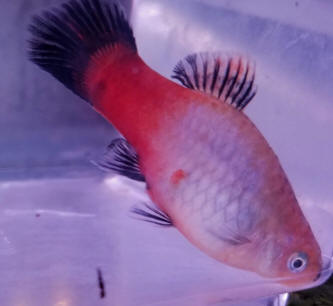 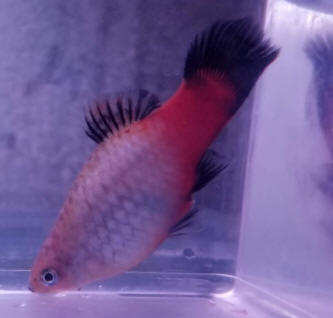 |
|
Platy problem
2/26/19
My female platy, who has given birth before, has a small, bulbous match
extruding from her anal orifice. It looks as if a fry got stuck being born.
What is happening?
<Likely a degree of prolapse... part of the combined sex and excretory
process extending outside the body... Usually due to nutrition, water
quality issues; with a modicum of genetic predisposition mixed in>
The fish is still eating and swimming well.
<Good>
I am struggling with excessive mold in this tank. Thanks for helping.
<Do your best to keep up the environment, provide sufficient
roughage/greenery in the diet and this bit should pull back in on its own.
Please read here:
http://www.wetwebmedia.com/fwsubwebindex/platyfdgfaqs.htm
Bob Fenner>
Re: Platy problem
2/27/19
Thanks a lot. I’ll keep trying.
<Way to go Laura. BobF>
Thin Platy 11/7/17
Good morning,
I suspect that I may have a problem with one of my Coral/Sunset Platies.
He is very small compared to my other varieties of Platy and he does not
seem to put any weight on regardless of his healthy appetite.
Behaviour:
His behaviour is nothing out of the ordinary; he is active, feeds well
and doesn't hide away. He does however like to stay close to the
surface, a little more than the others but not so much as to cause
worry.
Appearance:
His appearance is where my concern comes from. As mentioned he is small
and slender (as is the other Coral/Sunset) but he doesn't have the
rounded belly that a normal, healthy Platy would. His fins are not
clamped, he has no scales missing, sores or anything of that nature. His
faeces is not stringy or clear and he has no protrusions from his anus.
My thoughts were that this is likely some kind of internal parasite but
after doing some research, I am very worried that this may be a
mycobacterium infection.
Now, I don't want to jump to any conclusions (some forums seem to think
every ailment is TB these days) but because of his flat belly, this
alters his shape somewhat. I do not believe that his spine is bent
though.
Environment and tank history:
The tank is 180 litres with an external filter.
It was cycled without fish for 2 months almost a year ago, with 4 fish
being added every 2 to 3 weeks thereafter.
Weekly 30% water changes (once a month 50 %)
Current stock:
8 Platies of various strains.
6 Dwarf Chain Loaches.
The tank is moderately planted and is maintained at 24 degrees
centigrade.
Ammonia 0
Nitrite 0
Nitrate approx 10ppm.
Ph 8
I live in a hard water area but I have no means of testing the hardness.
History of illness:
Stringy, long, white faeces in most fish.
This was successfully treated with Octozin about 4 months ago and has
not returned. After investigating I realised this was due to feeding
frozen brine shrimp. It has not returned since I stopped feeding this.
Now I feed Spirulina flake and various premium flakes and occasional
live foods.
Fungal infection of small wound on the side of Mickey Mouse Platy, the
wound was from aggression. The fish was removed, put in a hospital tank
with aquarium salt added. Fish given Methylene blue bath weekly until
fully
healed. The treatment was successful and the fish was returned to main
aquarium after being clear of symptoms for a month.
The tank did have a pair of Dwarf Gouramis who died without explanation
within 2 months of purchase. I think these were very weak fish with the
problems that most DGs seem to have now.
Another Platy died with similar symptoms to those described above
approximately 2 months ago.
Initially I dosed Myxazin in case it was bacterial but this had no
effect.
I then tried to worm the tank with medication added to the water in
accordance with the instructions (2 weeks after the Myxazin) I have
since read on your site wormers should be added to the food so maybe
that is why I was unsuccessful.
He had the symptoms for approximately 4 weeks before he died, in my
opinion he didn't appear to be suffering so I decided against
euthanasia.
Finally to my questions!
I do not want to have a knee jerk reaction and dump in anti bacterial
medication, followed by anti parasite medication and so on and so on.
Does this sound like parasites or bacterial infection to you? Could he
just be a genetically weak fish?
What course of action would you recommend and what medication, if any,
would you suggest? I am based in the UK.
In the event of a suspected case of fish TB, what actions would you
take?
I have read conflicting information on Mycobacterium. Some say it is
present in most tanks but only raises its head when the fish are in a
stressed state with a compromised immune system. Others say it has to be
introduced somehow, what are your thoughts on this?
If the fish are not showing symptoms and live in otherwise good
conditions, is it really necessary to euthanise and start again? (this
is the opinion of many forums) I have spoken to a vet who says I just
need to be aware that it is in the environment and make sure that there
is no cross contamination to other tanks. The fish can lead normal and
healthy lives.
The latter is my intention.
If mycobacterium is as infectious as everyone seems to think and as
widespread, wouldn't it be safe to assume that it's in most tanks,
especially since it can often be present without symptoms?
At the moment I do not intend to stock any more fish unless I can get an
'all clear' somehow in the tank. In a few years when my last fish has
gone, what is the best way to disinfect as I understand mycobacterium is
resistant to heat and bleach. I have read alcohol is the way to go,
would you concur?
My apologies for how long winded this was. I have done extensive reading
which has given conflicting advice and left me with more questions than
answers..
I hope your fantastic team can clear this up for me.
I am a big fan of your site, thank you so much for sharing your
knowledge.
Regards
Colin
<Hello Colin, and thanks for the kind words. I fear this is a common
problem with Platies, especially the more inbred strains such as Sunset
and Coral Platies. May be genetic, the old "runt in the litter"
situation, but more than likely some type of Mycobacteria-like wasting
disease. Often seen in livebearers. Environment may be a factor: when I
maintain tanks of livebearers, but neglect maintenance for a few months,
I find more example of these runt-like fish within the group. High
nitrate, low oxygen, high temperatures, and monotonous diet are all
things I think about in this situation, and try to remedy. Sometimes the
fish recover, sometimes not. In any case, Mycobacteria isn't treatable,
certainly not without access to antibiotics. There is indeed some debate
about where this bacterial infection comes from and whether it's in all
tanks all the time -- but I think it probably is, and being highly
contagious, even if it isn't in your tank when you set it up, sooner or
later something brings it in. That said,
Mycobacteria-like infections are rare, and it's that combination of
their rarity and the fact they appear out of nowhere sometimes years
after you add new fish that is odd -- and why I personally believe the
Mycobacteria
are in most/all tanks, but some stress factor causes the fish to get
sick.
There's no real point trying to eliminate it from the aquarium given
that healthy fish shrug it off without any problems, and even if you
sterilise your tank, the filter and your fish may carry the bacteria
anyways. Bottom
line, while you can certainly try to use an internal bacterial
medication to deal with the Mycobacteria, isolating the sick fish, even
in a floating breeding trap, is probably easier and cheaper. The
bacteria will probably have got to the other fish by now, so unless you
treat the whole tank, hospitalising the one sick fish isn't going to
change anything. Besides, healthy fish aren't going to succumb to
Mycobacteria, all else being equal.
As I say, there does seem to be a stress (and perhaps genetics) factor
at work here, with Mycobacteria not being a major threat to most fish
most of the time. The one alternative that might bear thinking about is
Hexamita, a
parasite that infects the gut (preventing proper absorption of the food,
among other things) and its most distinctive symptom is indeed white,
stringy faeces. Metronidazole is the classic medication here, but in the
UK and EU, you'll find it easier to get hold of something called eSHa
HEXAMITA that is cheaper and available at pet shops. Good luck, Neale.>
Re Thin Platy 11/8/17
Hi Neale,
Thank you very much indeed for your response.
<Most welcome.>
It would make sense for mycobacterium to be in most tanks; I buy all of
my fish from a reputable source who's husbandry is first class but I
suppose all it would take is one infected fish (or even a net) and
before you know
it, the entire system has the bacteria.
<Quite so.>
I am very happy I asked the questions now because, like I mentioned
before, most forums would have you reaching for the clove oil at the
first sign of trouble!
<Which isn't a bad approach in terms of humanely destroying sick fish --
something the hobby hasn't always been good at. Plus, identifying and
destroying sick fish does, at the very least, reduce the chances of
other fish becoming infected. So in a sense, that's what happens in the
wild where the "old and sick" would be picked off by predators.>
I will ensure that I keep up the maintenance and look to give them an
improved diet.
<Cool.>
Whether or not I put more fish in this tank or not remains to be seen, I
think I will let it run down naturally, get rid of all hardscape, plants
and filter and convert it to a FOWLR tank in a few years time.
<Understandable. Freshwater fishkeeping can be harder than marine
fishkeeping in some ways -- the fact fish are bred to be as cheap as
possible does mean that diseases are more of a risk. If you compare a $2
guppy with a $50 Butterflyfish, the whole economics is going to be
different, with the retailer making much more effort to ensure his stock
is healthy so that doesn't lose money when the fish is in his tanks.
Flip side though is that marine tanks are more expensive to set up and
maintain, and every bit as prone to problems, whether health issues,
algae, or whatever. There's something to be said for brackish water in
this issue, in that you can set up the basics as marine (limestone rock,
coral sand, a skimmer) and keep a few interesting fish just for fun,
like Puffers or Scats, and then, when the time comes, transition these
to a FOWLR system by adding your live rock and whatever marine fish you
want.>
I really appreciate you taking the time to respond to me, I can stop
stressing and just get back to enjoying my fish.
Thanks again
Colin
<And thanks for the kind words. Cheers, Neale.>
Thin Platy 11/8/17
Hello again Neale,
I forgot to say, thank you for recommending the medication, I will
purchase that straight away.
<No problem. I'm just aware that not all the medications recommended by
Americans are available in other parts of the world.>
Regards
Colin
<Good luck! Neale.>
Re: Thin Platy 11/9/17
Hi Neale
Keeping brackish species is something I have always wanted to try,
especially Bumblebee Gobies or some kind of Puffer.
<Figure 8s and BBGs get along well. Neither is suitable for marine, but
a lot of the hardware itself can be used for a future marine tank; the
salt, hydrometer, limestone rocks, etc. There are a lot more species out
there, maybe not traded widely, but available if you know where to ask,
including some that can/should go marine at some point, such as
Chelonodon patoca, one of the prettiest of all the puffers.>
This is definitely something to consider!
Regards
Colin
<Cheers, Neale.>
|
My fish's tail... Lernaea? 3/24/17
So I have attached the best picture I could take of my fish's tail. It is clear,
but as you can see there's a white line on it, she never had this before, I've
had her for about a week and saw she had it today. What is it?
<Can't be absolutely sure as your large pic file is blurry, but this appears to
be an "Anchorworm"; crustacean parasite... common in imported livebearers and
goldfish raised in ponds.>
And are my other fish at risk?
<Mmm; yes... There are a few approaches to treatment... Please read here:
http://www.wetwebmedia.com/fwsubwebindex/anchorwrmfaqs.htm
and write back if your path is not clear. Bob Fenner>
|
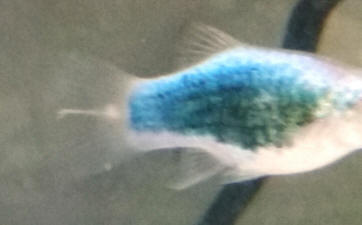 |
|
Something not quite right with Platies
3/12/17
Hello!
<Hello Lena,>
I'm writing in regards to my 150 liter Juwel aquarium. It's been up and
running for around three months now, and the tank is fully cycled. It's
parameters are
0. Ammonia,
0. Nitrite,
10. Nitrate
8.2 PH.
Temperate: 25 degree Celsius
<This all sounds good.>
The surface of the water ripples from filtration, so I assume aeration is
adequate.
<Should be. These are well-designed tanks, and provided you don't overstock
them, the built-in filter mixes air and water very well, ensuring good water
quality.>
It's moderately planted with Java Moss, Java Ferns and Anubias, (plenty of
hiding spaces) and has two filters running; the inbuilt one and a secondary
Eheim. The fish seem to have no issue with the water movement; I added the
Eheim as the focal piece of the tank is a large piece of store bought
driftwood and its shape was causing dead spots.
<Good.>
The stock list is
5 Kuhli loaches (one of which has giraffe-like print? Is this common?)
<Not uncommon. There are several species of Pangio, easily confused, and
frequently jumbled up in the trade. So you could easily have a true Kuhli
(Pangio kuhlii) alongside Pangio semicincta, Pangio myersi or one of the
other Pangio species in the trade.>
2 Albino Corydoras
1 Whiptail Catfish
1 Male Platy
1 Male Swordtail
4 Female Platies (2 of which are orange High-Fins)
I have no plans on adding anymore fish, I'm already concerned that it's
veering on the side of overstocked.
<In 150 litres you're fine. Indeed, I'd add a few more Corydoras so you get
a decent school of 5-6 specimens, and if it were me, a couple more Whiptails
too, as they're fun to watch in groups. The males hold tiny territories and
do their best to flirt with nearby females.>
Every day they receive either spectrum community fish pellets or flakes (I
like to change it up) and also an algae tab, which vanishes over the course
of 5-6 hours. I also supplement their diet with freeze-dried blood-worms
once a week (The platies/swordtail seem largely disinterested in these, but
the Corydoras and whiptail cat make short work of them).
My first attempt of purchasing Platies was a nightmare; of the original
five, only one remains; the female Hi-Fin in the picture, which I assume was
not related to the lot that died. The ones that passed away stopped eating,
sat themselves above the filter out-take, grew mossy and white and passed
away within one or two days. No other fish were affected. I purchased a
female Oreo platy a week later from another store, no problems.
All fish are drip-acclimatized.
A week later, (and now about a week ago) I purchased three more platys from
a different shipment to the same store where I purchased the original ones
(I suspected the store was at fault, now I'm suspecting the supplier). Two
of the platies, (female), have settled in with no problem, but the Male
platy (pictured) has begun clamping and flashing. He is strongly swimming,
attempting to mate with everything and has a full appetite, but I'm
concerned about a repeat event. Are there any preventative measures I can
take?
<See below.>
Additionally, my pregnant looking Hi-Fin has isolated herself from the rest
of the pack since the new fishes introduction. I assumed she was just going
to give birth, and I have spotted a handful of grey fry in the tank, but
I'm concerned about the fact that despite all her other fins are looking
good, her pelvic fins are glued to her body and she looks to be in slight
distress. Her anus also looks swollen, but could this just be from her
giving birth?
<Possibly.>
Why would her fins be clamped up beneath her?
<Normally, stress.>
Thank you in advance, regards, Lena
<As you've experienced, the quality of Platies is middling to poor, at least
in the UK. This is a problem with livebearers across the board really. All
the farmed livebearers have been inbred to the Nth degree, and on top of
that, because they're "easy" to breed, and sold as cheap fish, fish farms
don't put a whole lot of effort into producing good quality livestock.
Bacterial infections as well as things like Camallanus worms seem to be
endemic. Your best approach is to buy specimens from a local breeder, as
those should be much healthier, or alternatively, skip the farmed
livebearers in favour of the less inbred wild-type livebearers such as Limia
nigrofasciata. In any case, I'd tend to adopt a 'wait and see' approach
here. I'd also be minded to use eSHa HEXAMITA, a product sold in Europe, or
alternatively in the US, Metronidazole, to treat against Hexamita
infections. At low level these and similar parasites cause wasting in a
variety of fish, including livebearers. They're otherwise difficult to treat
using the standard medications. Do also note that Platies prefer cool, hard,
alkaline water and will never do well in warm, soft or acidic water. While
middling temperatures (24-25 C) and hardness (around 10 degrees dH) should
suit Platies and other community fish, anything warmer or softer than that
isn't going to work. Cheers, Neale.>
|
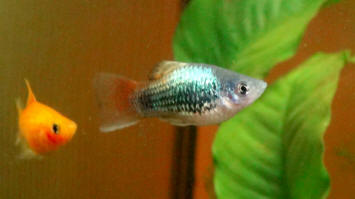
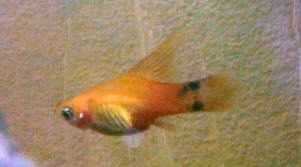 |
|
"Big", the Platy...
9/23/16
Hi, Neale - our sunset wag Platy, Big, is starting to live up to his
name and we're getting worried. He's the reason we have this huge tank,
but he's gotten listless, hanging out in the back corner under the
plants. His belly has gotten bigger, and the yellow part of his abdomen
is looking more pale.
<That is indeed what your photo suggests, and this isn't a good sign
with livebearers. Usually associated with stress, sometimes Slime
Disease (also called Costia), sometimes a bacterial infection causing
Dropsy, other times a 'wasting disease' such as Mycobacteriosis. I've
not seen many such specimens recover once they start turning pale. You
could medicate as per Slime Disease and/or internal bacterial
infections, but isolating the fish is a good idea. If the fish doesn't
show any sign of recovery, in all honesty I tend to destroy humanely any
such fish to prevent infecting other specimens. Generally this isn't
"catchy" as such, though exposing a group of fish to stress can of
course trigger a succession of fish becoming sick.>
He comes out into the mid-east, but not to the surface to eat. No
eating.
I'll attach a pic, such as I have. He doesn't even chase the gold dust
mollies, hardly, and he was really big on that at the beginning. Ideas?
Thanks, as ever. Hope you are doing well.
Tom
<Hope this helps, Neale.>
|
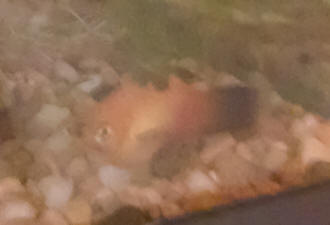 |
|
re: "Big", the Platy 9/24/16
He's been swimming more and pooped, we think, and is acting more normal, but
still spends a lot of time down in his corner. We were just talking about how
much time he used to spend up around the pump or by the heater, until we put all
the plants in and gave him a spot he liked better. I'm not sure the time spent
in the corner is more than the time spent hiding up by the filter. But his belly
looks swollen and lopsided, bigger on his right side. He's been through so
damned much that I hate the idea of putting him down. If this could spread,
though, that's a problem. We could put him in
the 10 gallon tank, but the pH on that is around 8 (dunno why)
<It's unlikely that the problem he's got is 'catchy'. The bacteria that cause
this type of problem are ambient in all tanks; it's stress of one sort or
another that makes the fish vulnerable. So while you might isolate
the fish in a breeding trap to stop him being badgered by other fish or
struggling against the current, there's no pressing need to remove him from the
tank. On the other hand, there are some fish diseases, like Neon Tetra Disease,
that are genuinely catchy.>
You talked about humanely putting him down, but how is that done?
<Various methods, but the cheapest and most humane is probably Clove Oil.
http://www.wetwebmedia.com/euthanasia.htm
Put 30 drops in a litre of aquarium water, then lower the fish into this using a
net. It'll become sedated very quickly, and after half an hour will be dead as a
doornail. Older methods, such as putting a fish in a freezer, aren't considered
humane by vets and not recommended. Clove Oil is widely sold in drugstores for
various uses including treating toothache. A small bottle will cost $5 or so,
and will last you for years (assuming you're not killing fish every day!). It
also happens to smell lovely!!!>
Gah.
Tom
<Cheers, Neale.>
re: "Big"... sigh. Never mind. 9/24/16
Big died suddenly. He had been swimming around normally, then we didn't see him
for a while and I found him current jammed in the plants, dead
Dang. :(
<Oh dear. Well, that solves that problem. To some degree, fishkeeping is like
gardening. For whatever reason, some plants do great in your garden, while
others never seem to thrive. Same here: you buy a bunch of different fish that
sound like they should be happy in your tank, but you'll very quickly establish
your tank works well for just a subset of those fish. If you stick with the fish
you've had good experiences with, particular when starting out, you'll find the
hobby quite simple and easy. Don't imagine for a moment I'm saying this lightly;
I care deeply that all pet animals should be cared for well. But at the end of
the day virtually all "good" fishkeepers starting out making mistakes and losing
fish. Good luck, Neale.>
|
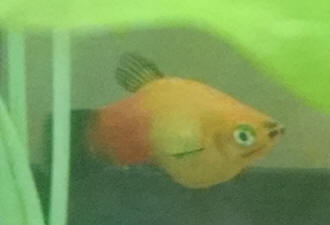 |
Platy fish loss /RMF 5/3/16
Hi Crew,
Thank you so much for taking time out of your busy schedules to answer
my question.
<We're here to help others enjoy, be successful>
I looked over everything on your page
<All 14k?>
but could not find a solution to my exact problem. I have an established
community tropical tank and within the past month or so I have lost two
of my platy fish that I have one for a year and another for about 7
months. The first that died started loosing a lot of weight and
began getting weird things on his scales that looked liked dry skin
flaking off and he started sitting on the bottom of the tank and
breathing rapidly.
<Mmm; sounds/reads like possibly Trichodina, or Costia... look up both
these genera... or...>
But then he would zoom around the tank all of a sudden and I thought he
was okay, and he was going up to feed
during most of this time. The second platy also started to sit on the
bottom but he declined much more rapidly than the first, and would nudge
himself into the corner on the tank and lay on his side and just breathe
heavily. He too lost weight and would either hide away, lay on his side
on the bottom of the tank, or swim at the top of the water listlessly as
if gasping for air at the water's surface. His gill's became so
stretched away and open they looked like two gaping slits on the side of
his face. I have introduced other fish since these and I am wondering if
this is some sort of internal parasite?
<Maybe>
It is very hard to figure out what might have caused their death since
so many of the symptoms sound alike, and I am deathly afraid of
medicating for the wrong disease as I have over-medicated in the past
and lost so many of my beloved fish.
<Ah, you are wise here. MANY more organisms are lost to mis-medicating
than pathogenic disease. MOST problems are environmental in cause,
source, and most effective treatments involve correcting environment,
bolstering nutrition>
I also have Cory cats and a Bristlenose Pleco in the tank,
<Do watch at "lights out" time to see if this catfish is "riding" your
other fishes... They can be the source of mortalities like those you
describe>
which I know are sensitive to medications.
<Mmm; Loricariids are not so much different than most fish groups>
Any advice you have would be so helpful I am concerned for my other
fish, especially for one pregnant guppy who is beginning to display some
of the same symptoms as the others did, very red swollen gills, rapid
and heavy
breathy, hiding and laying on bottom, overall darkening of color on body
and eyes. I am so afraid my whole tank may be infected with what ever
this is, and have been doing daily water changes to try to keep
everything extra clean. Thank you so much again for any insight you may
have.
Sincerely,
Kate Miller
<Please send along water quality test information, your set up,
maintenance procedures (water change schedule et al.), foods,
feeding.... Your platies may "just be getting old"...
Poeciliids don't live long; but there may be some useful clues and
responses you/we can provide. Bob Fenner>
Platy fish loss /Neale
5/4/16
Hi Crew,
Thank you so much for taking time out of your busy schedules to answer
my question. I looked over everything on your page but could not find a
solution to my exact problem. I have an established community tropical
tank and within the past month or so I have lost two of my platy fish
that I have one for a year and another for about 7 months. The first
that died started loosing a lot of weight and began getting weird things
on his scales that looked liked dry skin flaking off and he started
sitting on the bottom of the tank and breathing rapidly.
<As Bob has suggested, Costia (also known as Slime Disease) is one
possibility here, though I'd be surprised if a Bristlenose was sucking
on the infected fish -- Ancistrus are normally extremely well behaved.
Costia is difficult to treat, but I've had good success with a
combination of eSHa EXIT and seawater dips.>
But then he would zoom around the tank all of a sudden and I thought he
was okay, and he was going up to feed during most of this time.
<Understood; and unfortunately, recognised.>
The second platy also started to sit on the bottom but he declined much
more rapidly than the first, and would nudge himself into the corner on
the tank and lay on his side and just breathe heavily. He too lost
weight and would either hide away, lay on his side on the bottom of the
tank, or swim at the top of the water listlessly as if gasping for air
at the water's surface. His gill's became so stretched away and open
they looked like two gaping slits on the side of his face. I have
introduced other fish since these and I am wondering if this is some
sort of internal parasite?
<Possibly, but seems to be a problem with farmed livebearers across the
board. Alongside Costia, you might consider a Mycobacteria infection,
sometimes called Wasting Disease, which is very commonly seen among
Guppies and other livebearers. These infections are untreatable, and
appear to be latent among many types of fish, and triggered by some type
of environmental stress perhaps, or diet, or even bad luck.>
It is very hard to figure out what might have caused their death since
so many of the symptoms sound alike, and I am deathly afraid of
medicating for the wrong disease as I have over-medicated in the past
and lost so many of my beloved fish.
<Correct.>
I also have Cory cats and a Bristlenose Pleco in the tank, which I know
are sensitive to medications. Any advice you have would be so helpful I
am concerned for my other fish, especially for one pregnant guppy who is
beginning to display some of the same symptoms as the others did, very
red swollen gills, rapid and heavy breathy, hiding and laying on bottom,
overall darkening of color on body and eyes. I am so afraid my whole
tank may be infected with what ever this is, and have been doing daily
water changes to try to keep everything extra clean. Thank you so much
again for any insight you may have.
<The good news, I suppose, is that Wasting Disease among livebearers
doesn't seem to jump to dissimilar types of fish, so your catfish,
tetras or barbs should all be fine. If the same thing is happening each
time, isolating and humanely destroying infected fish may be helpful in
slowing down the spread of the disease. Antibiotics are an option, but
their success rate with Mycobacteria infections is very low, and
probably not cost effective with small fish like Platies. The other tack
is to understand that Mycobacteria infections come in with farmed fish
but are
triggered by environmental conditions. Platies, for example, are low-end
tropical fish from slow-moving streams and ponds. So the right
conditions for them would be cool (22-24 C/72-75 F) and with gentle
water current.
Hardness and pH would be high. Nitrate should be as low as practical. As
herbivores, their diet should be based around algae and softened greens;
vitamin deficiency can certainly make fish less able to fight off some
infections. Nothing completely certain here, sadly, but some ideas at
least.>
Sincerely,
Kate
<Cheers, Neale.>
Platy fish loss 5/13/16
Hi Guys,
Thanks for your response and sorry it's taken me so long to get back to
you. My tank set up is currently a 10 gallon I have 2 panda Cory cats,
two albino Cory cats, one Pygmy Cory, one albino Bristlenose Pleco, one
small male platy and two female guppies. I now know this is too many
fish for such a small tank and I will be setting up a 20 gallon this
Friday.
<Wise. 10 gallon tanks are tricky to stock and maintain. 20 gallons
gives you a good amount of space to work with. I'm a fan of them, and
consider them the minimum for "easy" fishkeeping.>
Will it be okay to move the fish to the new tank without going through a
full cycle first?
<Absolutely. The trick is carrying across the filter. Disconnect from
the old tank (with fish still there). Connect up to the new tank, filled
with dechlorinated water of course, and switch on. Let it run for 10
minutes to check there's no leaks. If all looks good, switch the heater
off in the old tank, let it cool for 5 minutes, then carry across to the
new tank. Plug
in, switch on, and wait for the tank to warm across to around the same
temperature as old tank. A degree or two difference isn't a big deal.
Once the new tank is nice and warm, net the fish and carry them across
from the old tank to the new one. Job done! This assumes water chemistry
is similar between the two. Which will be the case if you aren't
diddling about with water softeners, salt, etc.>
I am afraid if I take the weeks to cycle they may not last. I was doing
bi-weekly water changes of about 50% but am now doing daily water
changes of 30-50% as I had an ammonia spike. With the daily water
changes my levels read nitrate 0, nitrite 0, ammonia 0, pH 7.0, and temp
is 76. I alternate between feeding them Omega One veggie mini pellets,
tropical flakes, freeze-dried and frozen blood worms, Hikari bottom
feeder sinking wafers, Hikari sinking Carnivore pellets (only once in a
while) and tropical algae wafers. I also try to provide fresh greens,
cucumber, squash, celery, etc.
at least several times a week. I feed once a day and try to feed only
small proportions. The albino Cory cats seem to be very red in the gills
and have whitish looking patches on them and my albino Bristlenose also
has some white patches on both his inner sides as if he is missing some
of his armored scales. I am not sure if he was always like this or if I
am
just now noticing it due to being hyper sensitive to every little thing.
<Wise to be. It does sound as if this tank isn't "quite right" and the
extra space may well be the key to success. Get ammonia and nitrite down
to zero, consistently, and these mild inflammations should fix
themselves.>
The platy and one female guppy have been having extremely long and
stringy white feces, about twice the length of their body if not longer,
while the other female guppy had a semi-thick white pointy thing
protruding from her last night that she seemed unable to pass. It seemed
to be coming from her vaginal area rather than her anus
<Interesting. Sometimes dead/stillborn fry come out when livebearers are
stressed. That's the better of two possibilities when livebearers
miscarry.
The bad option is when the dead fry don't come out, and become sources
of infection as they rot. Almost always fatal. The trick, of course, is
to avoid miscarriages, which are almost always caused by stress.>
and I thought at first it was a fry since both the females were pregnant
but it looked too big plus the color was wrong and she seemed to be in
great distress unable to get it out. I tried to give her cooked pea but
she wouldn't eat and she is now just sitting on the ground in one of the
caves breathing very heavily and her gills are very red and stretched
open. I
thought it might be a worm but did not really look like one from what I
could see, however I was not able to get a very clear view as she kept
herself on the ground and I did not want to cause her any unnecessary
extra stress.
<If it's silvery-grey, it could easily be a dead fry. Faeces usually
off-white to brown, depending on what the fish has been eating. White or
clear faeces imply gut irritation, usually put down to parasites like
Hexamita. Worms are common in livebearers, but usually look exactly like
worms, often reddish, and may even be wriggling.>
Sorry for writing a book, I just wanted to make sure I didn't leave
anything out this time, thank you again so much for taking the time to
read all this you guys are so great and helpful!
<3,
Kate
<Cheers, Neale.>
Re: Platy fish loss 5/14/16
Well the female with the strange thing hanging out died yesterday, now
the third fish I have lost in the past month or two now.
<If all the same species, Platies, I'd suggesting avoiding them in
future.
Sometimes your aquarium or water chemistry aren't right for a given
species. Sometimes the supplier has got in a bad batch, and it's not
worth buying more. In short, wait awhile before buying any new fish just
to see how things pan out with the remainder. A month to six weeks is a
good hiatus. If all is well, just avoid Platies and try other fish.>
I believe it may have been a dead fry inside her that she was too weak
to push out.
<Can happen.>
It does concern me that I have lost three fish that I have had for
awhile in such a short amount of time.
<See above, and preceding messages.>
Wondering if the long string white/clear feces that you mentioned may be
Hexamita could be the cause of all this?
<Hard to say. Hexamita may be (probably is) latent in a wide range of
tropical fish. But it only becomes a problem when the fish is, somehow,
stressed or otherwise not healthy. So while heavy Hexamita infections
surely do cause fatalities, the $64,000 question is whether the Hexamita
is the root cause of those deaths or merely the thing that killed an
already
unhealthy fish.>
I have seen my last remaining male platy and female guppy flashing but
it has only happened once or twice in the past week or so and I thought
they may be trying to remove the long feces strands from them.
Thanks for your time,
Kate
<Hexamita is treated using Metronidazole. Not much else works. It
(probably) isn't "catchy" as such, so if stress factors are removed, the
remaining fish should be fine. Cheers, Neale.>
|
|

